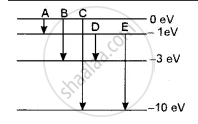Advertisements
Advertisements
Question
The diagram below shows the electric field (E) and magnetic field (B) components of an electromagnetic wave at a certain time and location.

The direction of the propagation of the electromagnetic wave is ______.
Options
perpendicular to E and B and out of plane of the paper.
perpendicular to E and B and into the plane of the paper.
parallel and in the same direction as E.
parallel and in the same direction as B.
Solution
The direction of the propagation of the electromagnetic wave is perpendicular to E and B and out of plane of the paper.
Explanation:
Direction of propagation of the electromagnetic wave is given by `vec"E" xx vec"B"`. Here `vec"B"` is along the +X axis. `vec"E"` is along the -Y axis. So, applying the right-hand rule, the propagation of the electromagnetic wave is perpendicular to `vec"E"` and `vec"B"` and out of plane of the paper.
APPEARS IN
RELATED QUESTIONS
How is the speed of em-waves in vacuum determined by the electric and magnetic field?
How does a charge q oscillating at certain frequency produce electromagnetic waves?
Sketch a schematic diagram depicting electric and magnetic fields for an electromagnetic wave propagating along the Z-direction.
Can an electromagnetic wave be polarised?
A point charge is moving along a straight line with a constant velocity v. Consider a small area A perpendicular to the motion of the charge. Calculate the displacement current through the area when its distance from the charge is x. The value of x is not large, so that the electric field at any instant is essentially given by Coulomb's law.

The energy levels of an atom of a certain element are shown in the given figure. Which one of the transitions A, B, C, D or E will result in the emission of photons of electromagnetic radiation of wavelength 618.75 nm? Support your answer with mathematical calculations.
The dimension of `1/(mu_0 ∈_0)` is
Write notes on Gauss' law in magnetism.
Write notes on Ampere-Maxwell law.
Discuss the source of electromagnetic waves.
Which of the following electromagnetic radiations has the smallest wave length?
